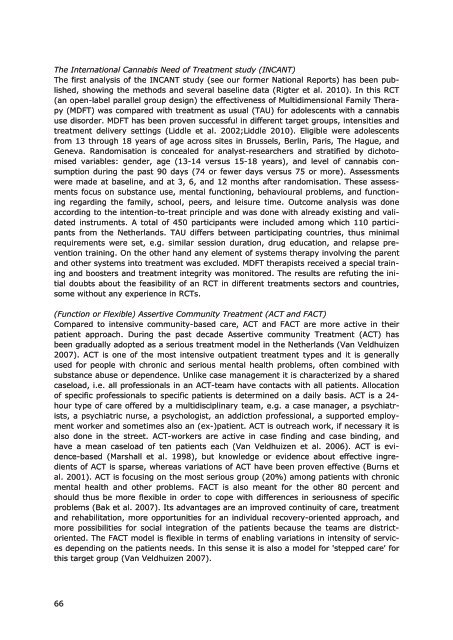The Netherlands Drug Situation 2010 - Trimbos-instituut
The Netherlands Drug Situation 2010 - Trimbos-instituut
The Netherlands Drug Situation 2010 - Trimbos-instituut
You also want an ePaper? Increase the reach of your titles
YUMPU automatically turns print PDFs into web optimized ePapers that Google loves.
<strong>The</strong> International Cannabis Need of Treatment study (INCANT)<strong>The</strong> first analysis of the INCANT study (see our former National Reports) has been published,showing the methods and several baseline data (Rigter et al. <strong>2010</strong>). In this RCT(an open-label parallel group design) the effectiveness of Multidimensional Family <strong>The</strong>rapy(MDFT) was compared with treatment as usual (TAU) for adolescents with a cannabisuse disorder. MDFT has been proven successful in different target groups, intensities andtreatment delivery settings (Liddle et al. 2002;Liddle <strong>2010</strong>). Eligible were adolescentsfrom 13 through 18 years of age across sites in Brussels, Berlin, Paris, <strong>The</strong> Hague, andGeneva. Randomisation is concealed for analyst-researchers and stratified by dichotomisedvariables: gender, age (13-14 versus 15-18 years), and level of cannabis consumptionduring the past 90 days (74 or fewer days versus 75 or more). Assessmentswere made at baseline, and at 3, 6, and 12 months after randomisation. <strong>The</strong>se assessmentsfocus on substance use, mental functioning, behavioural problems, and functioningregarding the family, school, peers, and leisure time. Outcome analysis was doneaccording to the intention-to-treat principle and was done with already existing and validatedinstruments. A total of 450 participants were included among which 110 participantsfrom the <strong>Netherlands</strong>. TAU differs between participating countries, thus minimalrequirements were set, e.g. similar session duration, drug education, and relapse preventiontraining. On the other hand any element of systems therapy involving the parentand other systems into treatment was excluded. MDFT therapists received a special trainingand boosters and treatment integrity was monitored. <strong>The</strong> results are refuting the initialdoubts about the feasibility of an RCT in different treatments sectors and countries,some without any experience in RCTs.(Function or Flexible) Assertive Community Treatment (ACT and FACT)Compared to intensive community-based care, ACT and FACT are more active in theirpatient approach. During the past decade Assertive community Treatment (ACT) hasbeen gradually adopted as a serious treatment model in the <strong>Netherlands</strong> (Van Veldhuizen2007). ACT is one of the most intensive outpatient treatment types and it is generallyused for people with chronic and serious mental health problems, often combined withsubstance abuse or dependence. Unlike case management it is characterized by a sharedcaseload, i.e. all professionals in an ACT-team have contacts with all patients. Allocationof specific professionals to specific patients is determined on a daily basis. ACT is a 24-hour type of care offered by a multidisciplinary team, e.g. a case manager, a psychiatrists,a psychiatric nurse, a psychologist, an addiction professional, a supported employmentworker and sometimes also an (ex-)patient. ACT is outreach work, if necessary it isalso done in the street. ACT-workers are active in case finding and case binding, andhave a mean caseload of ten patients each (Van Veldhuizen et al. 2006). ACT is evidence-based(Marshall et al. 1998), but knowledge or evidence about effective ingredientsof ACT is sparse, whereas variations of ACT have been proven effective (Burns etal. 2001). ACT is focusing on the most serious group (20%) among patients with chronicmental health and other problems. FACT is also meant for the other 80 percent andshould thus be more flexible in order to cope with differences in seriousness of specificproblems (Bak et al. 2007). Its advantages are an improved continuity of care, treatmentand rehabilitation, more opportunities for an individual recovery-oriented approach, andmore possibilities for social integration of the patients because the teams are districtoriented.<strong>The</strong> FACT model is flexible in terms of enabling variations in intensity of servicesdepending on the patients needs. In this sense it is also a model for 'stepped care' forthis target group (Van Veldhuizen 2007).66




